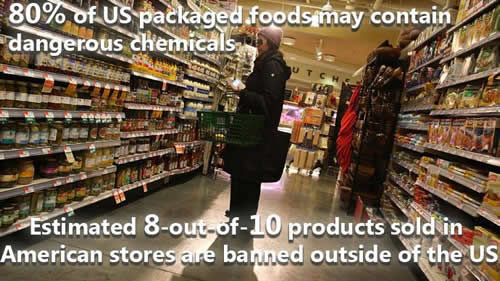 80 percent of US packaged foods may contain dangerous chemicals:
80 percent of US packaged foods may contain dangerous chemicals:
Six common food additives found in an estimated 8-out-of-10 products sold in American stores are banned outside of the US, the Mail claims, putting millions of Americans at risk of consuming chemicals considered too dangerous for humans in other countries.
Grocery shop items including best-selling soft-drinks and cereal sold in the US contain additives such as brominated vegetable oil, olestra and others that have been banned in the European Union and elsewhere.
The Daily Mail cites ‘Rich Food, Poor Food,’ a recently published book by Jayson Calton and Mira Calton, as the source for their claim that the majority of American groceries contain the additives.
Among the common items containing the chemicals are Mountain Dew, Chex Mix and Hungry Man frozen dinners, which are made with additives outlawed overseas due to health risks. The Caltons say these products are filled with some of the six “Banned Bad Boys” that are used in America but absent in supermarkets overseas.
“One of the most common ‘Bad Boys’ is different variations of food coloring, which actually is made from petroleum and is found in everyday items like soda, sports drinks, mac and cheese, cake, candy and several other common, American products,” reports the Daily Mail. One of the chemicals in that food coloring, they add, has been proven to cause various different cancers. Those artificial dyes have been outlawed in Norway, Finland, Austria, France and the United Kingdom
Another additive, brominated vegetable oil, has been banned in over 100 countries because it’s been linked to causing major organ damage, birth defects and hearing loss, among other side effects. Brominated vegetable oil, or BVO, is used in Mountain Dew, Gatorade, Powerade and Squirt — and around 10 percent of all drinks sold in the US.
A petition started earlier this year to get BVOs out of beverages sold in the US received over 206,000 signatures on the website Change.org.
“BVO is banned other places in the world, so these companies already have a replacement for it,” the petition’s author, Sarah Kavanagh, told The New York Times. “I don’t see why they don’t just make the switch.”
Another additive, potassium bromate, is used in American bakeries to speed up the process of preparing wraps, rolls and other bread products. It’s derived from the same chemical as BVO, though, and has been tied to causing kidney damage and cancer. That’s why it’s been outlawed in Europe, Canada and China, but not in the US.
Also on the Calton’s list is azodicarbonamide, a chemical the Daily Mail notes is used to make things like bleach and rubber yoga mats.
Azodicarbonamide is “approved to be a bleaching agent in cereal flour” and is “permitted for direct addition to food for human consumption,” according to the Food and Drug Administration. Along with waxy preservatives called butylated hydroxyanisole (BHA) and butylated hydroxytoluene (BHT) used in bubble gums, though, the additive has been banned in parts of Europe for potential health risks.
Rounding out the authors’ ‘Bad Boys’ list are Synthetic growth hormones rBGH and rBST and the chemical arsenic. They’ve both been banned in the EU for a variety of reasons, and perhaps for good reason: the arsenic put in American poultry can kill a human being if consumed in a high enough dosage.
Source: rt.com, minds.com
Health Inspirations – Tips – Inspirational Quotes, Pictures and Motivational Thought
<<<< Welcome Home >>>>






It is amazing how far removed from the simple art of cooking we have become. We have traded health for convience and now we are paying the price.